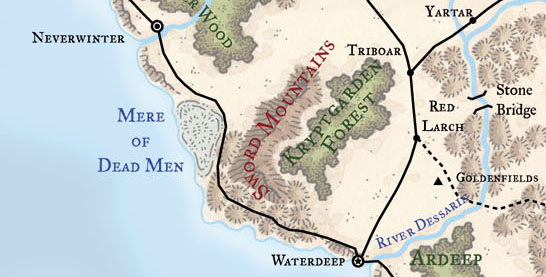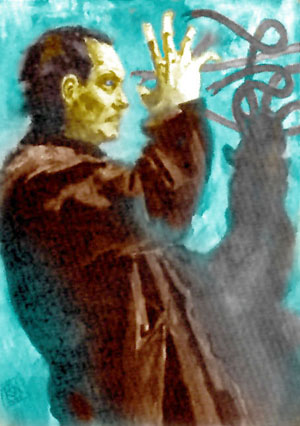LIMITING SOLUTIONS
The mechanical gate is a specific example of a broader category of chokers in which the potential solutions to a problem are limited. This limitation self-evidently creates an experiential chokepoint.
Limiting solutions merely for the sake of limiting solutions is almost always a railroad-by-design. What can avoid the railroad, however, is only limiting the potential solutions to a problem within a specific paradigm.
For example, the PCs encounter the Sphinx and it demands an answer to its riddle. Within the paradigm of “solving the riddle” there is only one solution (because the riddle only has one answer). Outside of that paradigm, however, the PCs could also kill the Sphinx, teleport past the Sphinx, or hire someone to deal with the Sphinx for them. (If you opt for the last of these, however, I recommend not marrying the handsome young lad who solves the problem for you. It’ll end in tears of blood.)
The example of the Sphinx, however, also reveals why the technique of limiting solutions can be effective: It creates a sense of accomplishment when the answer to a problem is discovered. (Or when you manage to MacGyver your way around it.) An adventure that consists only of Sphinxes who say, “Say any word and you can go ahead.” is a lot less interesting than puzzling out the answer to an actual riddle. (Or, alternatively, slipping on your ring of invisibility and tricking Gollum into leading you to the surface.)
INFORMATION ARROWS
In addition to limiting solutions, you can also limit information. The classic example of this, once again, is the clue in a mystery scenario. (Here the information provided by the clue is also the limited solution to the problem of where you need to go to find the next clue, which also demonstrates how much overlap there is between these different categories of chokers.)
But the limiting (or structuring) of information can also encourage PCs to interact with a situation in a specific way. Or create entirely new ways for them to interact with it.
A simple example: The PCs discover information that they can use to blackmail the programming director of Arcadia Television. Without that information, blackmail is impossible. With that information, blackmail becomes possible. (Limiting information can be used to prevent certain choices from being made by withholding knowledge that they’re possible.)
Another example: Someone is being framed for a crime. If the PCs are aware of the character’s innocence when they begin their investigation, that’s a very different scenario than if the PCs are ignorant of it.
Let’s take a more complicated example. Imagine a simple hexcrawl in which the small village of Laciton is surrounded by six hexes. These hexes are keyed with:
- The ruins of the Keep of the Dracolich
- A bleakened fairy ring
- A mammoth cave system used by goblin marauders
- A lake that’s home to a prophetic sylph
- A tower haunted by “ghosts” who are actually dimensionally-displaced wizards
- The dreamgroves of the ash-scarred ents
In one version of this hexcrawl, the PCs can go to the center of Laciton and see a billboard that lists all six of the interesting locations surrounding the village. There is no choker and the information is freely available: They can simply choose which location they want to investigate first.
In another version of this hexcrawl, the PCs can ask around town. The villagers know that there’s a ruined keep west of town. They know that goblin marauders are attacking the outlying farms, but they don’t know where they’re coming from. They also warn people away from the “haunted tower”. In this campaign, although the default hexcrawl structures still make it possible for the PCs to visit any of the six locations they want, each limited piece of information creates an arrow which points them preferentially towards the things they know about.
SCARCITY OF RESOURCES
In the blackmail example above, the information was a necessary tool and the withholding of that information necessarily removed the ability to make certain choices. Information, however, is not the only resource which can be required in order to make a particular choice possible.
For example, the PCs might want to blow up the demon with a bazooka. But if they don’t have a bazooka, they obviously can’t do that. Similarly, 1st level D&D characters generally don’t have access to a teleport spell, so they won’t be able to teleport into Skull Mountain.
This choker can also appear during play if the PCs are deprived of a resource: Their swords can be sundered. Their hotel rooms plundered. Their evidence confiscated. Their informants killed.
What I generally recommend when it comes to a scarcity of resources, however, is that it is almost always the right course of action to make it possible for the PCs to gain the resources they want. That doesn’t have to be easy, of course: When Buffy the Vampire Slayer and the Scooby Gang wanted a bazooka to blow up a demon, they had to leverage their existing resources (Xander’s vestigial memories of being an enchanted soldier) in order to stage a difficult raid on a military armory.
If the resource they want simply doesn’t exist, is there some way that it can be created? For example, there might not be any blackmail available on the local politician because he’s actually a pretty decent guy. That doesn’t mean they can’t set up a honeytrap and create the blackmail material they need.
DEADLINE
When the resource being limited is specifically time, you’ve created a deadline.
The limitation of time has the practical effect of taking certain options off the table. For example, if you know the Priests of Orcus are sacrificing Lady Karna at the stroke of midnight, then the option of performing a tactical retreat and coming back in the morning after you’ve had a chance to recuperate is no longer viable. (Assuming you want to save her, of course.)
However, you can also use deadlines to make choices more meaningful: When the Joker tells Batman that he only has time to save one of the hostages from dying in a gasoline explosion, that creates a crucible for the character which reveals deep truths. (Although sometimes what’s revealed is that you can outsmart the Kobyashi Maru and save everybody. Don’t get so attached to your crucibles that you start negating player choices that would circumvent them.)
UNIQUE REWARD
The opposite of a limited resource is a unique reward which can be only be gained in a specific way.
A pile of gold coins is not a unique reward; there are a lot of gold coins out there. Even the bazooka from the local armory isn’t a unique reward because, again, there are other bazookas out there.
Having to go to the Lady of the Lake in order to claim Excalibur? That’s a choker.
Like the Sphinx and its riddle, clever PCs may be able to find other methods of obtaining the reward. (And an Arthurian campaign where King Arthur murders the Lady of the Lake and steals her sword is definitely going to be a fascinating iteration of the legend.) But, generally speaking, the unique reward is a giant carrot that says, “Come over and do this really cool thing so that you can get this really awesome reward.”
EXTERNAL EVENTS
An external event is one which cannot be anticipated (or prevented) by the PCs because it originates from outside the domain of their experience.
For example, the Red Dragon Gang decides to put a hit out on the PCs. You make a note in your prep documents that on November 18th dragon ninjas are going to track the PCs down and attack them.
If the PCs were previously interacting with the Red Dragon Gang (or, possibly, just aware of them) this is not an external event: The attack could theoretically be prevented if the PCs wipe the gang out before the 18th or negotiate a truce with them or fake their own deaths or just coincidentally kill the dragon ninjas who were supposed to be attacking them on the 18th.
If the PCs were NOT previously interacting with the gang, however, it’s an external event. And it’s a choker because there’s no functional way for the PCs to avoid the attack. (Hypothetically, of course, they might have just left town or something. Which is why this is a choker and not a railroad.)
When taken to an extreme – when the PCs are subjected to an endless sequence of external events over which they can have no influence or control – these chokers can be hideously frustrating. In practice, fortunately, that’s very unlikely: The reaction to being ambushed by dragon ninjas is generally going to be figuring out who sent the dragon ninjas, which immediately gets the PCs involved in events over which they do have control.
And external events can be incredibly useful to the GM because they automatically provide the certainty which simplifies smart prep: Since the PCs basically can’t avoid them, the GM can assume they happen without needing to spend a lot of time on contingency plans. They are bangs that can be carefully incubated and then unleashed at the perfect moment.
External events, properly implemented, can also be very effective in providing a larger structure for the campaign. My Ptolus: In the Shadow of the Spire campaign, for example, started with the PCs waking up after losing two years of their memories. In preparing the campaign, I knew that Act II would be triggered when someone they had hired to find a magical artifact during their period of amnesia returned to tell them that the artifact had been located.
With that external event in my pocket, I could confidently build the interlocking scenarios of Act II without needing to worry about whether or not a specific outcome would emerge from Act I.
It should be noted that this didn’t mean that the events of Act I were irrelevant. Quite the contrary: Ninety sessions into Act II, the decisions they made in Act I continue to resonate daily in the campaign. Intriguingly, this is largely because the decisions they made created a rich tapestry of chokers: They chose alliances and they rejected others. They destroyed some enemies and allowed others to escape. They learned some secrets and gave others away before they knew what they had. All of those decisions limited their resources and the information that they held, which has had a deep impact on how they’ve been able to approach Act II and the problems it presents.
FINAL THOUGHTS
The Czege Principle maintains that, “When one person is the author of both the character’s adversity and its resolution, play isn’t fun.”
This is a principle which applies equally to roleplaying games, storytelling games, and improvisational theater. In the case of roleplaying games, it generally means two things:
First, railroads are boring. The GM creates the adversity and they also create the resolution of the adversity. (Then they force the players into acting out the resolution they’ve already created.)
Second, chokers are necessary. Chokers are either the means by which the GM creates adversity or the result of that adversity in play. A campaign without chokers is a featureless expanse in which the PCs face no adversity of which the players are not the ultimate architect. Here, too, adversity and solution flow from a single spring and the result is lusterless.
Avoiding the railroad does not mean that the GM must abandon their creative agenda. Quite the opposite, in fact. The GM must create richly and they must create deeply, so that when their creations meet the creativity of their players there will be greatness born in the clash of titanic ideas.
Addendum: I Want To Be Railroaded
Addendum: Random Railroads
How a Railroad Works




















